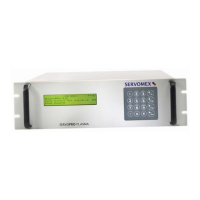
Do you have a question about the Servomex SERVOPRO k2001 and is the answer not in the manual?
| Measurement | Continuous |
|---|---|
| Gas Types | O2, CO2, CH4 |
| Technology | Infrared |
| Display | LCD |
| Communication Protocols | Modbus, RS232, RS485 |
| Power Supply | 100-240V AC, 50/60Hz |
| Operating Temperature | 0°C to 45°C |
| Response Time | T90 < 10 seconds |
| Mounting | Panel or wall mounting |
| Accuracy | ±1% of full scale |
| Outputs | Analog, digital, relay |
| Measurement Range | 0-100% (dependent on gas type) |
Explains warning symbols used in the manual and on the analyzer.
General caution against improper installation, operation, or service.
Warns about exposed high voltages and proper grounding requirements.
Warns against using flammable or corrosive gases and mentions it's not for hazardous areas.
Lists precautions for handling and storing high-pressure gas cylinders.
Describes hazards associated with argon and helium gases (asphyxiation).
Provides comprehensive safety guidelines for operation, handling, and maintenance.
Outlines the procedure and requirements for returning the analyzer for repair.
Details Servomex's ownership of software, firmware, and hardware.
Details detector type, measurement ranges, and resolutions.
Covers accuracy, drift, noise, and response time of the analyzer.
Includes dimensions, weight, operating conditions, and electrical requirements.
Outlines digital/alarm outputs, analog output, serial port, and optional features.
Provides a general description and details the sample gas introduction process.
Explains the power supply module and the core analysis section.
Details the analyzer's electronic components and user interface.
Identifies and describes the analyzer's front and rear panel controls and ports.
Guides on connecting the analyzer to the electrical power supply.
Details the recommended setup for the gas sampling and delivery lines.
Provides instructions for installing the analyzer unit into a cabinet.
Guides the user through the analyzer's configuration settings and options.
Explains the process of calibrating the analyzer with zero and span gases.
Guides on using the diagnostic menu to check analyzer status.
Describes the normal operating mode and displayed information.
Highlights specific requirements for using the 0-1 ppm measurement range.
Introduces the hidden menu for advanced settings.
Covers enabling Ethernet connectivity and setting the web password.
Explains DHCP settings and manual IP parameter configuration.
Provides steps for accessing and controlling the analyzer via a web browser.
Advises on periodic checks for cell counts and flow stability.
Offers practical advice for using the analyzer with different gas types.
Describes routine maintenance tasks and filter replacement.
Provides guidance on diagnosing and resolving analyzer issues.
Lists common problems, their possible causes, and remedies.
Explains what leaks are and how they affect system performance and accuracy.
Recommends specific types of pressure regulators for analytical systems.
Advises on the appropriate material and diameter for sample lines.
Recommends specific sample traps and their maintenance.
Details the procedure for purging regulators to ensure gas purity.
Provides practical guidelines and rules of thumb for system setup.
Explains the digital output for range, status, and alarm transmission.
Describes the dual digital dry contact outputs for process alarms.
Details the RS-232 serial communication option for remote data transmission.
Defines the parameters and format of data transmitted via RS-232.
Describes the automatic calibration feature and its operation.
Guides on inputting zero and span gas values for calibration.
Explains the steps for performing a manual calibration.
Describes how the analyzer performs automatic recalibration at set intervals.
Warns about operating with Helium background gas.